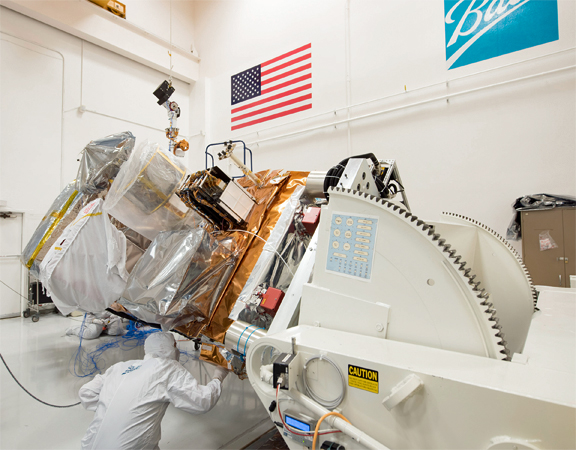[SatNews] Ball Aerospace & Technologies Corp. has integrated four of the five complex instruments that will fly onboard the nation’s next polar-orbiting weather satellite and is moving toward environmental testing by early 2016 with on-time delivery scheduled for late 2016, followed by launch scheduled for no later than the second quarter of 2017.

A Ball engineer inspects one of the sun sensors on the Joint Polar Satellite System( JPSS-1). Engineers have now installed four of the five flight instruments that will fly on the spacecraft when it launches in 2017.
Photo courtesy of Ball Aerospace.
Polar weather satellites contribute 85 percent of the data that goes into numerical weather prediction models. NOAA’s Joint Polar Satellite System (JPSS-1) will be responsible for delivering the primary contribution from the afternoon orbit. Launch of the instrument-loaded orbiter will continue accurate/reliable weather forecasting and provide severe storm warnings that protect lives and property across our nation.
When launched, JPSS-1 will continue the accurate and timely polar-orbiting weather data currently only available from the Suomi National Polar-orbiting Partnership (Suomi-NPP) satellite and it instruments, with a satellite bus also built by Ball Aerospace. On orbit since 2011, Suomi-NPP delivers operational high-quality atmospheric, oceanographic, and land surface data for the nation’s weather mission. The JPSS-1 instruments integrated to date include:
- Cross-track Infrared Sounder (CrlS)
- Visible Infrared Imaging Radiometer Suite (VIIRS)
- Ozone Mapping and Profiler Suite-Nadir (OMPS-N)
- Clouds and the Earth's Radiant Energy System (CERES)
“The steady progress on JPSS-1 means the nation will soon have a second next generation polar-orbiting satellite and the significance of that for protecting lives and property cannot be underestimated,” said Cary Ludtke, vice president and general manager of Ball’s Operational Space business unit. “Better forecasts are a critical enabler of what NOAA envisions as ‘A Weather-Ready Nation’ and Ball is proud to do its part.”
Following integration of the final instrument to fly on JPSS-1, Advanced Technology Microwave Sounder (ATMS) later this year, the JPSS-1 satellite will enter environmental testing. Under contract to NASA’s Goddard Space Flight Center, Ball Aerospace is responsible for designing and building the JPSS-1 satellite bus, building the OMPS-Nadir instrument, integrating all instruments, and performing satellite-level testing and launch support. NOAA provides the funding and requirements for JPSS and teams with NASA, which procures the flight and portions of the ground segment.


